Images
- The Altar of St. James in the Pistoia Cathedral
- Reliquary of the head of San Galgano
- Reliquary of the head of San Galgano (detail)
- Reliquary of the head of San Galgano (detail)
Pace di Valentino (also known as Pacino; Pacino Orafo) [1] was a Sienese goldsmith active from 1257 to 1296. [2] Little is known about his early life, but he was probably born between 1230 and 1235. [3] Though working chiefly in Siena, he also was established for a time in Pistoia, [1] and received numerous commissions from different popes. [3]
The first documented reference to Pace di Valentino is for two seals made in 1257. [3] In 1265 he received two significant commissions: the first was for a large golden chalice ("calicem magnum di auro") weighing about 11 pounds and a corresponding paten, both of which are now lost; the second was for an elaborate gold-plated silver book cover. These were items not made for daily use, and having received these requests suggests that he was well known and well regarded in his field. [1] Other notable works attributed to him include the chalice of San Atto made c. 1270, [2] and numerous figures in the late 13th-century Altar of St. James found the Pistoia Cathedral. [4] Some art historians suggest that he made the reliquary of San Galgano's head, now found in Siena's Museo dell'Opera del Duomo, [5] although this is disputed by others. [3] In addition, other extant documents indicate the details of his purchases of gold, silver, pearls, beads, and precious stones for use in his shop, as well as details of payments for works commissioned. [3]
He was the first Sienese goldsmith to work for the papal court (under popes Nicholas III, Martin IV, Honorius IV, and Boniface VIII) [3] and was actively working for Boniface VIII in the region of Montefiascone until at least 1296. [6] He was influential on other goldsmiths of the following generation, including Guccio di Mannaia. [7]
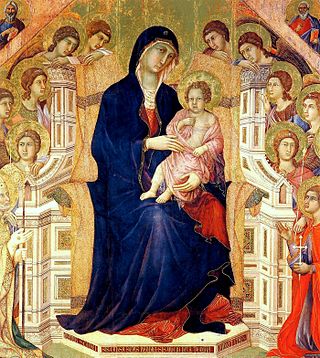
Duccio di Buoninsegna, commonly known as just Duccio, was an Italian painter active in Siena, Tuscany, in the late 13th and early 14th century. He was hired throughout his life to complete many important works in government and religious buildings around Italy. Duccio is considered one of the greatest Italian painters of the Middle Ages, and is credited with creating the painting styles of Trecento and the Sienese school. He also contributed significantly to the Sienese Gothic style.

Jacopo della Quercia, also known as Jacopo di Pietro d'Agnolo di Guarnieri, was an Italian sculptor of the Renaissance, a contemporary of Brunelleschi, Ghiberti and Donatello. He is considered a precursor of Michelangelo.
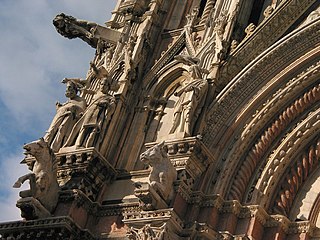
Giovanni Pisano was an Italian sculptor, painter and architect, who worked in the cities of Pisa, Siena and Pistoia. He is best known for his sculpture which shows the influence of both the French Gothic and the Ancient Roman art. Henry Moore, referring to his statues for the facade of Siena Cathedral, called him "the first modern sculptor".
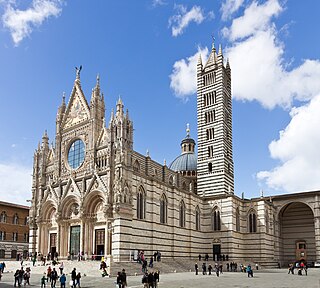
Siena Cathedral is a medieval church in Siena, Italy, dedicated from its earliest days as a Roman Catholic Marian church, and now dedicated to the Assumption of Mary.

Domenico di Pace Beccafumi was an Italian Renaissance-Mannerist painter active predominantly in Siena. He is considered one of the last undiluted representatives of the Sienese school of painting.
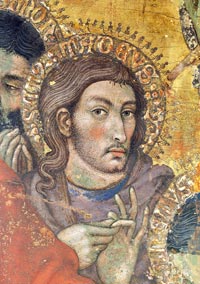
Taddeo di Bartolo, also known as Taddeo Bartoli, was an Italian painter of the Sienese School during the early Renaissance. His biography appears in the Vite of Giorgio Vasari, who claims that Taddeo was the uncle of Domenico di Bartolo.

Orvieto Cathedral is a large 14th-century Roman Catholic cathedral dedicated to the Assumption of the Virgin Mary and situated in the town of Orvieto in Umbria, central Italy. Since 1986, the cathedral in Orvieto has been the episcopal seat of the former Diocese of Todi as well.

Lucignano is a comune (municipality) in the Province of Arezzo in the Italian region Tuscany, located about 70 kilometres (43 mi) southeast of Florence and about 25 kilometres (16 mi) southwest of Arezzo.
The decade of the 1420s in art involved some significant events.

San Raimondo, also called San Raimondo al Refugio, is a Baroque style, Roman Catholic church located on the intersection of Via del Refugio and Via di Fiera Vecchia, in the Terzo of Camollia of the city of Siena, region of Tuscany, Italy. The church is dedicated to St Raymond of Pennafort.

Pistoia Cathedral, or Cathedral of Saint Zeno is the main religious building of Pistoia, Tuscany, central Italy, located in the Piazza del Duomo in the centre of the city. It is the seat of the Bishop of Pistoia and is dedicated to Saint Zeno of Verona.

The Palazzo Comunale, also known as the Palazzo del Popolo of San Gimignano has been the seat of the civic authority in the comune since the 13th century. It is located on the Piazza del Duomo close to the Collegiate Church of the Assumption of the Blessed Virgin Mary. The building and Collegiate Church are at the heart of the medieval town, and are part of the UNESCO World Heritage Site of the "Historic Centre of San Gimignano".

The Museo dell'Opera del Duomo in Florence, Italy is a museum containing many of the original works of art created for Florence Cathedral, including the adjacent Florence Baptistery and Giotto's Campanile. Most of the exterior sculptures have been removed from these cathedral buildings, usually replaced by replica pieces, with the museum conserving the originals.

Siena is a city in Tuscany, Italy. It is the capital of the province of Siena. Siena is the 12th largest city in the region by number of inhabitants, with a population of 53,062 as of 2022.

The Piccolomini Altarpiece is an architectural and sculptural altarpiece in the left-nave of Siena Cathedral, commissioned by cardinal Francesco Todeschini Piccolomini who expected it to become his tomb. However, he was elected Pope Pius III and buried in the Vatican. It was built between 1481 and 1485 by Andrea Bregno in Carrara marble, with additions in the following decades – these included four niche sculptures produced between 1501 and 1504 by Michelangelo of saints Peter, Augustine, Paul and Gregory. On top of the altar is the Madonna and Child, a sculpture (probably) by Jacopo della Quercia. The central painting of the Madonna is by Paolo di Giovanni Fei and from the late 14th century.
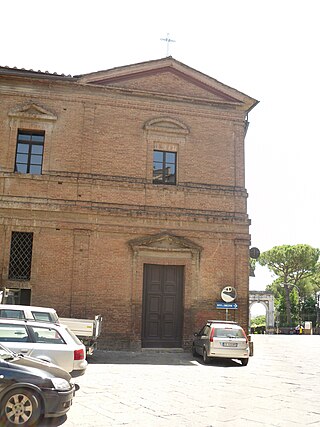
The Church of the Santuccio or Chiesa del Santuccio, is a small, Renaissance-style, Roman Catholic church located on Via Roma 69 in Siena, Italy. The church was once was part of the adjacent monastery of Santa Maria degli Angeli, occupied since 1362 by Augustinian nuns. The frescoed church is not part of the Polo Museale della Toscana, an association of museums of the Tuscan region.

Antonio Federighi was an Italian architect and sculptor of the Renaissance period. He was born and active mainly in Siena, Italy.
Meo di Pero, also called Meo di Piero was an Italian painter active in Siena in a Gothic style. He worked in the studio of Cristoforo di Bindoccio. All the latter paintings are generally co-attributed to Meo, since no independent work is known.
Guccio di Mannaia was an Italian goldsmith from Siena, Italy active from 1288 to 1322. He is best known for a 13th-century decorated gold-plated chalice which contains the first documented use of translucent enamels using the technique known as basse-taille.

The Reliquary of the Santo Corporale of Bolsena is a medieval artwork made by Sienese goldsmith Ugolino di Vieri in 1337-1338. The reliquary is made of gold-plated silver and enamel and is c.139 cm high. The reliquary was recently transferred to the cathedral museum from the cathedral itself where it had been from the time of its creation.